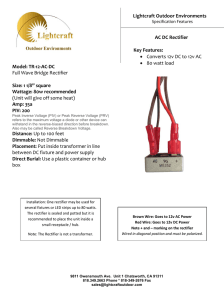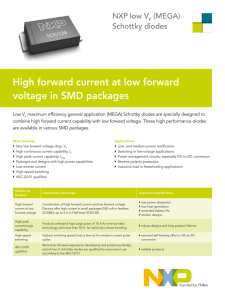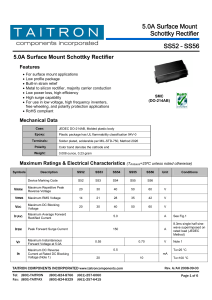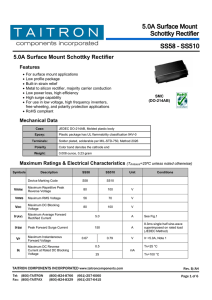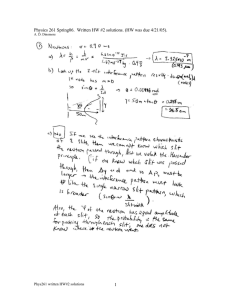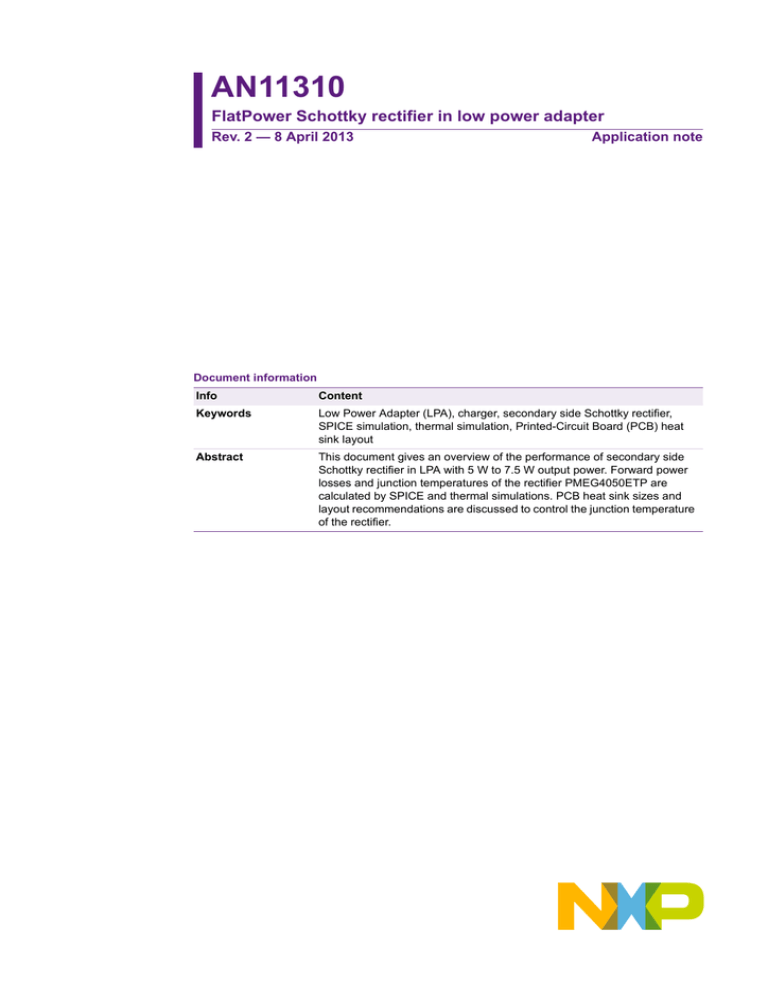
AN11310
FlatPower Schottky rectifier in low power adapter
Rev. 2 — 8 April 2013
Application note
Document information
Info
Content
Keywords
Low Power Adapter (LPA), charger, secondary side Schottky rectifier,
SPICE simulation, thermal simulation, Printed-Circuit Board (PCB) heat
sink layout
Abstract
This document gives an overview of the performance of secondary side
Schottky rectifier in LPA with 5 W to 7.5 W output power. Forward power
losses and junction temperatures of the rectifier PMEG4050ETP are
calculated by SPICE and thermal simulations. PCB heat sink sizes and
layout recommendations are discussed to control the junction temperature
of the rectifier.
AN11310
NXP Semiconductors
FlatPower Schottky rectifier in low power adapter
Revision history
Rev
Date
Description
2
20130408
Added Table 3 “Schottky rectifiers in SOD128 for LPA: highlights”
1
20130115
Initial version
Contact information
For more information, please visit: http://www.nxp.com
For sales office addresses, please send an email to: salesaddresses@nxp.com
AN11310
Application note
All information provided in this document is subject to legal disclaimers.
Rev. 2 — 8 April 2013
© NXP B.V. 2013. All rights reserved.
2 of 13
AN11310
NXP Semiconductors
FlatPower Schottky rectifier in low power adapter
1. Introduction
LPA in the range from 5 W to 7.5 W, as for example used for battery charging of mobile
phones, typically choose Switched Mode Power Supply (SMPS) in a single switch flyback
topology. Schottky rectifiers are a popular solution as secondary side rectifiers in these
designs, as they offer significantly lower forward losses compared to PN-rectifier,
increasing power efficiency.
This application note discusses the performance of a 40 V Schottky rectifier in NXP
Semiconductors FlatPower SOD128 package, with focus on most important parameter for
device selection and power losses generated under operation at full load. Power losses
are calculated by SPICE simulations using simplified waveforms and junction
temperatures by thermal simulations for different sizes of solder pads, i.e. additional heat
sinks, on single layer PCB.
2. Flyback converter
2.1 Basic topology of a flyback converter
A flyback converter consists of an input, a power and an output stage. The input stage is
connected to AC mains and its purpose is to convert the AC to a smoothed, unregulated
DC voltage. The basic function blocks of the input stage are a bridge rectifier, followed by
a smoothing capacitor. The capacitor smooths the rectified voltage and acts as an energy
storage device.
The unregulated DC is then passed to the power stage, in which power is converted. The
power stage is controlled by a switch and contains a transformer. Energy stored in the
transformer is controlled by the switching frequency and duty cycle of the switch. When
the switch is closed, the primary side of the transformer is connected to the input voltage,
current rises and energy is stored. The voltage in the secondary winding is negative and
the Schottky rectifier is reverse-biased. No current is flowing through it and energy to the
output is delivered from the output capacitor.
When the switch is opened, the current in the primary side drops, the voltage at the
secondary winding reverses and the rectifier becomes forward biased, allowing current
flow, or energy transfer, to the output and the output capacitor. As a consequence of
current flowing through the rectifier, forward losses are generated and temperature rises
in the device.
AN11310
Application note
All information provided in this document is subject to legal disclaimers.
Rev. 2 — 8 April 2013
© NXP B.V. 2013. All rights reserved.
3 of 13
AN11310
NXP Semiconductors
FlatPower Schottky rectifier in low power adapter
Figure 1 shows a basic application schematic.
Schottky rectifier
Rinrush
+
VOUT
-
VCC
controller
FB
GND
Fig 1.
DRAIN
SOURCE
Basic application schematic of a flyback converter
2.2 Current waveform and associated forward losses of a Schottky
rectifier in a low power flyback converter
The current through the Schottky rectifier in a flyback converter is either continuous or
discontinuous. Continuous current never reaches zero while for discontinuous mode the
current drops down to zero and stays there for some time. The waveform has a more or
less triangular shape.
Figure 2 shows a simplified waveform in comparison to a more realistic one for
discontinuous mode. For a 7.5 W adapter with 1.5 A output current, peak currents up to
6 A can occur, with switching frequencies typically in a range from 50 kHz to 150 kHz.
The more realistic waveform shows the ringing, associated to the leakage inductance of
the coils. In addition to the ringing, in steady state also peak current and duty cycle differ
from the simplified waveform. They do not only depend on the average output current but
also on size of the coils and additional circuitry, like a snubber across the rectifier.
The simplified waveform however is a good approach to investigate the effect of losses
associated to the forward voltage at high currents, by simple SPICE simulations. The
average losses in the rectifier will be in a similar range for both waveforms, if the average
current is the same and the rectifier is able to handle peak currents without a deviation in
the VF = f(IF) characteristic. At currents > IF(MAX) ohmic losses in the EPItaxial layer (EPI)
of the semiconductor can play a dominant role for an increase of forward voltage.
A simplified waveform with high peak current therefore is a good test to simulate full load
conditions and the ability of the device to handle high currents. In addition, a simulation
model for the magnetics and the driving scheme on the primary side has to be very
elaborate to reflect all current and voltage-related matters in an isolated flyback. This
effort was not spent for the investigations in the following chapters.
AN11310
Application note
All information provided in this document is subject to legal disclaimers.
Rev. 2 — 8 April 2013
© NXP B.V. 2013. All rights reserved.
4 of 13
AN11310
NXP Semiconductors
FlatPower Schottky rectifier in low power adapter
7
IF
(A)
5
3
(1)
1
(2)
-1
t (µs)
(1)
IF waveform with ringing
IF(AV) = 1.47 A, PAV = 579 mW
(2) IF simplified waveform
IF(AV) = 1.48 A, PAV = 594 mW
Fig 2.
Simplified and realistic current waveform through the secondary side rectifier,
discontinuous mode
3. Important parameters for selection of a Schottky rectifier
3.1 IF - maximum forward current
Forward current limits in Schottky rectifier data sheets are often specified as
• IF(AV): average forward current. The parameter is based on a pulsed, rectangular
waveform with a duty cycle of typically 0.5.
• IF: forward current limit for DC conditions.
IF(AV) is a useful parameter, as the current through the Schottky in a low power flyback
SMPS is a pulsed, triangular current. Peak currents of the triangular waveform occur at
less time than for a rectangular waveform, so in principle higher peak values are allowed
for triangular waveforms.
For further information how to calculate peak values of pulsed waveforms or convert
average values of different shaped waveforms please see Ref. 2 “Application Note
AN10808 Thermal consideration of NXP FlatPower MEGA Schottky barrier rectifier Selection criteria” on www.nxp.com.
For a design focusing on low losses, it is beneficial to choose a rectifier with IF(AV) limits
that are at least three times greater than the average output current of the application.
AN11310
Application note
All information provided in this document is subject to legal disclaimers.
Rev. 2 — 8 April 2013
© NXP B.V. 2013. All rights reserved.
5 of 13
AN11310
NXP Semiconductors
FlatPower Schottky rectifier in low power adapter
3.2 VF - forward voltage
With respect to on-state power losses and the efficiency of the adapter, VF is the most
important parameter. The lower the VF, the lower the power loss and the better the power
efficiency.
As the temperature goes up, the forward voltage VF decreases and the losses are
reduced, by the way increasing the efficiency of the LPA.
3.3 VR - reverse voltage
The reverse voltage limit specifies the maximum allowable reverse voltage, at which a
certain reverse current is not exceeded. Beyond this limit, safe operation cannot be
guaranteed.
When selecting a rectifier with higher reverse voltage limits, the forward voltage VF
typically increases due to the higher Schottky barrier used. To gain efficiency, a diode with
the lowest possible breakdown voltage is beneficial. In an LPA with 5 V output voltage, up
to 35 V arise across the Schottky when the diode is in a blocking state. This voltage is
related to the winding ratio of the transformer and will differ from design to design.
• VR requirements for an isolated flyback are often calculated by:
V peak turnsratio + V OUT + V F
• For an adapter connected to 230 V mains (+ 10 %) and a turns ratio of for
example 15, peak reverse voltage calculates to:
253V 1 414 15 + 5V + 0 5V = 29 35V
To add a safety margin, a minimum of VR 40 V is recommended for a 5 V adapter.
3.4 IR - leakage current
Leakage current can have a negative effect on two important design features of modern
low power adapter: overall efficiency and standby power losses.
Usually, the leakage current through the Schottky rectifier when in blocking state does not
significantly effect the efficiency of a flyback transformer under operation, as the energy
(minus ohmic losses) is reused every switching cycle and ohmic losses are rather small.
In addition, the average blocking voltage across the rectifier is much lower than peak
voltages so that overall losses typically do not lead to thermal runaway. Peak leakage
current occurs at the peak reverse voltage of typically 30 V - 35 V and a device junction
temperature of 85 °C.
For standby power considerations, the data sheet gives information about the leakage at
5 V and 25 °C ambient temperature. The value must be small enough, so that standby
power loss requirements of the design are fulfilled.
3.5 Cd - diode capacitance
Diode capacitance is associated with the Schottky barrier and depends on reverse voltage
conditions. Lower capacitance improves ElectroMagnetic Interference (EMI) behavior.
AN11310
Application note
All information provided in this document is subject to legal disclaimers.
Rev. 2 — 8 April 2013
© NXP B.V. 2013. All rights reserved.
6 of 13
AN11310
NXP Semiconductors
FlatPower Schottky rectifier in low power adapter
3.6 trr - reverse recovery time
To measure trr, the rectifier is forward biased and forward current is limited to a value IX.
Next, the rectifier is reverse biased while reverse current is limited to the same value IX
and the time needed for the current to decrease to 20 % of IX is measured. This time is
called trr.
Small values of trr result in less reverse current flow when the Schottky rectifier is reversed
biased, improving EMI.
3.7 Ptot - maximum allowed power dissipation
The package of a semiconductor influences its maximum power dissipation capabilities,
the required PCB space and height of the application.
The maximum allowed power dissipation Ptot of the secondary side rectifier in an LPA
mainly depends on VF IF, i.e. the generated forward losses. The dissipated power
generates heat. The package of the rectifier and PCB layout conduct this heat to
ambience, mainly to the PCB, via conduction through the leads and heat sinks.
4. Schottky rectifier in FlatPower SOD128 package for 5.0 W - 7.5 W LPA
NXP Semiconductors MEGA Schottky rectifiers in FlatPower SOD128 package are
rugged, low VF devices and the high-power density package with solid copper clips on the
silicon die supports small and power efficient designs.
PMEG4050ETP is a 40 V, 5 A IF(AV) rectifier ideal for 7.5 W non-synchronous flyback
adapter with up to 1.5 A average output current. To improve efficiency and power losses,
a diode with higher IF(AV) limits than the average output of the adapter is beneficial. A
device rated to 5 A IF(AV) has significant lower VF at 6 A peak than a device rated to, for
example 3 A average, reducing forward power losses.
Figure 3 indicates the maximum IF(AV) when the device is operated at different ambient
temperatures, while mounted on a single layer PCB with 1 cm² mounting pad for the
cathode. With a duty cycle of 50 % and an ambient temperature of 75 °C, PMEG4050ETP
allows for IF(AV) > 1.5 A.
AN11310
Application note
All information provided in this document is subject to legal disclaimers.
Rev. 2 — 8 April 2013
© NXP B.V. 2013. All rights reserved.
7 of 13
AN11310
NXP Semiconductors
FlatPower Schottky rectifier in low power adapter
006aac714
6
IF(AV)
(A)
(1)
4
(2)
(3)
2
(4)
0
0
50
100
150
200
Tamb (°C)
FR4 PCB, mounting pad for cathode 1 cm2
Tj = 175 °C
(1) = 1.0
(2) = 0.9
(3) = 0.8
(4) = 0.5
Fig 3.
Average forward current as a function of ambient temperature; typical values
If higher breakdown voltage limits are required, PMEG6030ETP is a 60 V, 3 A IF(AV)
rectifier and suited for 5 W non-synchronous adapter with 1 A average output current.
5. Power dissipation and thermal simulations
5.1 Simulation of average power dissipation of PMEG4050ETP
in 7.5 W LPA
A SPICE simulation with a simplified waveform is useful to estimate the average power
dissipation of a secondary side rectifier in an LPA. The waveforms shown in Figure 4 were
generated by a SPICE simulation tool. A current source drives a 6 A peak, triangular
current (1.5 A average) through the Schottky rectifier. The software calculates average
power values.
With this setup, Ptot of PMEG4050ETP is around 600 mW at 25 °C junction temperature.
As a SPICE model usually gives values at 25 °C junction temperature, the calculated Ptot
will be too high compared to the conditions in a real application. Under operation, the
Schottky rectifier will get hot and forward losses will decrease due to the lowered forward
voltage VF at high temperatures. To estimate the decrease in Ptot, a SPICE model for
PMEG4050ETP at 85 °C junction temperature was extracted. The same simulation
calculates a decrease of Ptot(AV) of about 90 mW.
AN11310
Application note
All information provided in this document is subject to legal disclaimers.
Rev. 2 — 8 April 2013
© NXP B.V. 2013. All rights reserved.
8 of 13
AN11310
NXP Semiconductors
FlatPower Schottky rectifier in low power adapter
3.0
P
(W)
2.5
(1)
(2)
2.0
1.5
1.0
0.5
0
-0.5
t (µs)
(1) Tj = 25 °C, IF(AV) = 1.5 A
PAV = 594 mW
(2) Tj = 85 °C, IF(AV) = 1.5 A
PAV = 501 mW
Fig 4.
Simplified power dissipation of PMEG4050ETP in a 7.5 W flyback transformer
at 25 °C and 85 °C
Table 1.
SPICE models for PMEG4050ETP at 25 °C and 85 °C junction temperature
SPICE model for 25 °C junction temperature
SPICE model for 85 °C junction temperature
.SUBCKT PMEG4050ETP 1 2
.SUBCKT PMEG4050ETP_85°C 1 2
R1 1 2 1E+006
R1 1 2 1.5E+004
D1 1 2
D1 1 2
+ DIODE
+ DIODE
.MODEL DIODE D( IS = 3.589E-006 N = 1.017 .MODEL DIODE D( IS = 0.0004 N = 1.2 BV =
BV = 48.4 IBV = 0.0003 RS = 0.009506 CJO = 48.4 IBV = 0.0003 RS = 0.014 CJO =
1.209E-009 VJ = 0.3154 M = 0.4858 C = 0.5 TT 1.209E-009 VJ = 0.3154 M = 0.4858 FC = 0.5
TT = 0 EG = 0.69 XTI = 2)
= 0 EG = 0.69 XTI = 2)
.ENDS
.ENDS
5.2 Thermal simulations of PMEG4050ETP on a single layer PCB
Thermal simulations were performed to investigate the rectifier junction temperature with
different sizes of heat sinks. 500 mW Ptot was used for the simulations, according to the
simulated power losses under full load at 85 °C.
The simulation setup is a single layer PCB in free air. To compare the influence of copper
thickness of heat sinks and signal traces, 35 m and 70 m was used for the simulation.
The SOD128 package model represents a heat source attached to the PCB.
AN11310
Application note
All information provided in this document is subject to legal disclaimers.
Rev. 2 — 8 April 2013
© NXP B.V. 2013. All rights reserved.
9 of 13
AN11310
NXP Semiconductors
FlatPower Schottky rectifier in low power adapter
PCB layout, 0.5 cm2 heat sink at
cathode and anode
Fig 5.
3D picture of the Schottky
rectifier on PCB
Thermal flow, cathode lead on
the upper side
Examples of PCB layout, model of the Schottky rectifier in SOD128 package and thermal flow
The simulation calculates < 80 °C on a PCB with two times 0.5 cm2 heat sinks of 70 m in
free air:
Table 2.
Thermal simulation results for PMEG4050ETP
P power dissipation, Tamb = 25 °C
copper thickness
mW
500
500
m
35
70
cm2
1+0
Tj
°C
Tlead cathode
°C
heat sink at cathode and anode
0.5 + 0.5
0.5 + 0.5
92.1
87.9
79.2
88.6
85.7
77
The simulation with 1 cm2 heat sink only at the cathode is shown in comparison to two
times 0.5 cm2 at anode and cathode to highlight the positive effect of distributed heat
sinks. Typically there is not enough space for the heat sinks as used for the simulation.
But surrounding components like capacitors, a transformer or a connector act as heat
sinks, resulting in a similar performance.
It is however strongly recommended to verify the temperatures of the power
semiconductors by measurements. The simulation here shall only indicate, that standard
layouts sufficiently control the junction temperature of a Schottky rectifier in SOD128
package in a 7.5 W LPA.
6. Heat sink layout
In this chapter some aspects of heat sinks design and increased solder pads are
discussed.
6.1 Heat sinks at one terminal comparing to heat sinks at both terminals
of the rectifier (anode and cathode)
It is beneficial to use heat sinks at both terminals of the Schottky rectifier, i.e. two heat
sinks with, for example 0.5 cm2 each, are more efficient for cooling than one heat sink of
1 cm2 at one terminal. The better the heat is distributed across the PCB, the more heat
can be transferred into space via radiation and convection. As the SOD128 package uses
solid copper clips from the top side of the die to the anode pin, heat conduction to both
AN11310
Application note
All information provided in this document is subject to legal disclaimers.
Rev. 2 — 8 April 2013
© NXP B.V. 2013. All rights reserved.
10 of 13
AN11310
NXP Semiconductors
FlatPower Schottky rectifier in low power adapter
sides of the package is supported. The cathode is soldered on the leadframe and has an
even slightly lower thermal resistance to the outside world. Figure 5 gives an overview of
the inside structure of the Schottky rectifier in SOD128.
As a rule of thumb the junction temperature will decrease by 5 % to 10 % when two heat
sinks are used, with an equal total covered area.
Drawback of an increased copper area at the anode is also an increased parasitic
capacitance on the PCB at the anode terminal, that can influence EMI. Using Schottky
diodes with small diode capacitance Cd and small trr improves EMI ruggedness.
Compared to other devices in SMB or flat SMB, SOD128 rectifier uses rather small dies,
with small capacitance and trr values.
6.2 Heat sinks on the bottom layer, thermal vias
If heat sinks are placed on the opposite site of the PCB, thermal vias must be used to
conduct the heat through it and the heat sinks at top and bottom should be shifted to
different areas of the PCB. As mentioned above, it is crucial to distribute the heat across
the PCB and placing a one-to-one copy of the heat sink directly underneath the top layer
does not result in significant additional cooling capabilities.
7. Conclusion
Medium power Schottky rectifiers in FlatPower SOD128 package are ideal for the usage
as a secondary side rectifier in 5 W - 7.5 W LPAs.
PMEG4050ETP and PMEG6030ETP are rated to 5 A and 3 A IF(AV) with respective 7 A
and 4.3 A DC ratings. With their low VF and the small but powerful SOD128 package,
these devices help to increase efficiency and ruggedness of LPA designs, while operation
at high peak currents is supported.
By using additional heat sinks on the PCB, the maximum junction temperature under full
load can be controlled.
Table 3.
Schottky rectifiers in SOD128 for LPA: highlights
Type number
Reverse voltage Average forward Forward voltage VF
VR(max)
voltage IF(AV)(max) T
Tamb = 25 C,
amb = 25 C;
IF = 1 A
IF = 3 A
Reverse current IR
Tamb = 25 C; VR = 5 V
PMEG4050ETP
40 V
5A
340 mV
390 mV
8 A
PMEG6030ETP
60 V
3A
380 mV
460 mV
4 A
PMEG6030EVP
60 V
3A
355 mV
420 mV
7 A
PMEG6045ETP
60 V
4.5 A
355 mV
420 mV
7 A
8. References
AN11310
Application note
[1]
Application Note AN11060 TEA172X 5 W to 11 W Power Supply/USB charger
[2]
Application Note AN10808 Thermal consideration of NXP FlatPower MEGA
Schottky barrier rectifier - Selection criteria
All information provided in this document is subject to legal disclaimers.
Rev. 2 — 8 April 2013
© NXP B.V. 2013. All rights reserved.
11 of 13
AN11310
NXP Semiconductors
FlatPower Schottky rectifier in low power adapter
9. Legal information
9.1
Definitions
Draft — The document is a draft version only. The content is still under
internal review and subject to formal approval, which may result in
modifications or additions. NXP Semiconductors does not give any
representations or warranties as to the accuracy or completeness of
information included herein and shall have no liability for the consequences of
use of such information.
9.2
Disclaimers
Limited warranty and liability — Information in this document is believed to
be accurate and reliable. However, NXP Semiconductors does not give any
representations or warranties, expressed or implied, as to the accuracy or
completeness of such information and shall have no liability for the
consequences of use of such information. NXP Semiconductors takes no
responsibility for the content in this document if provided by an information
source outside of NXP Semiconductors.
In no event shall NXP Semiconductors be liable for any indirect, incidental,
punitive, special or consequential damages (including - without limitation - lost
profits, lost savings, business interruption, costs related to the removal or
replacement of any products or rework charges) whether or not such
damages are based on tort (including negligence), warranty, breach of
contract or any other legal theory.
Notwithstanding any damages that customer might incur for any reason
whatsoever, NXP Semiconductors’ aggregate and cumulative liability towards
customer for the products described herein shall be limited in accordance
with the Terms and conditions of commercial sale of NXP Semiconductors.
Right to make changes — NXP Semiconductors reserves the right to make
changes to information published in this document, including without
limitation specifications and product descriptions, at any time and without
notice. This document supersedes and replaces all information supplied prior
to the publication hereof.
Suitability for use — NXP Semiconductors products are not designed,
authorized or warranted to be suitable for use in life support, life-critical or
safety-critical systems or equipment, nor in applications where failure or
malfunction of an NXP Semiconductors product can reasonably be expected
to result in personal injury, death or severe property or environmental
damage. NXP Semiconductors and its suppliers accept no liability for
inclusion and/or use of NXP Semiconductors products in such equipment or
applications and therefore such inclusion and/or use is at the customer’s own
risk.
Applications — Applications that are described herein for any of these
products are for illustrative purposes only. NXP Semiconductors makes no
representation or warranty that such applications will be suitable for the
specified use without further testing or modification.
AN11310
Application note
Customers are responsible for the design and operation of their applications
and products using NXP Semiconductors products, and NXP Semiconductors
accepts no liability for any assistance with applications or customer product
design. It is customer’s sole responsibility to determine whether the NXP
Semiconductors product is suitable and fit for the customer’s applications and
products planned, as well as for the planned application and use of
customer’s third party customer(s). Customers should provide appropriate
design and operating safeguards to minimize the risks associated with their
applications and products.
NXP Semiconductors does not accept any liability related to any default,
damage, costs or problem which is based on any weakness or default in the
customer’s applications or products, or the application or use by customer’s
third party customer(s). Customer is responsible for doing all necessary
testing for the customer’s applications and products using NXP
Semiconductors products in order to avoid a default of the applications and
the products or of the application or use by customer’s third party
customer(s). NXP does not accept any liability in this respect.
Export control — This document as well as the item(s) described herein
may be subject to export control regulations. Export might require a prior
authorization from competent authorities.
Evaluation products — This product is provided on an “as is” and “with all
faults” basis for evaluation purposes only. NXP Semiconductors, its affiliates
and their suppliers expressly disclaim all warranties, whether express, implied
or statutory, including but not limited to the implied warranties of
non-infringement, merchantability and fitness for a particular purpose. The
entire risk as to the quality, or arising out of the use or performance, of this
product remains with customer.
In no event shall NXP Semiconductors, its affiliates or their suppliers be liable
to customer for any special, indirect, consequential, punitive or incidental
damages (including without limitation damages for loss of business, business
interruption, loss of use, loss of data or information, and the like) arising out
the use of or inability to use the product, whether or not based on tort
(including negligence), strict liability, breach of contract, breach of warranty or
any other theory, even if advised of the possibility of such damages.
Notwithstanding any damages that customer might incur for any reason
whatsoever (including without limitation, all damages referenced above and
all direct or general damages), the entire liability of NXP Semiconductors, its
affiliates and their suppliers and customer’s exclusive remedy for all of the
foregoing shall be limited to actual damages incurred by customer based on
reasonable reliance up to the greater of the amount actually paid by customer
for the product or five dollars (US$5.00). The foregoing limitations, exclusions
and disclaimers shall apply to the maximum extent permitted by applicable
law, even if any remedy fails of its essential purpose.
9.3
Trademarks
Notice: All referenced brands, product names, service names and trademarks
are the property of their respective owners.
All information provided in this document is subject to legal disclaimers.
Rev. 2 — 8 April 2013
© NXP B.V. 2013. All rights reserved.
12 of 13
AN11310
NXP Semiconductors
FlatPower Schottky rectifier in low power adapter
10. Contents
1
2
2.1
2.2
3
3.1
3.2
3.3
3.4
3.5
3.6
3.7
4
5
5.1
5.2
6
6.1
6.2
7
8
9
9.1
9.2
9.3
10
Introduction . . . . . . . . . . . . . . . . . . . . . . . . . . . . 3
Flyback converter . . . . . . . . . . . . . . . . . . . . . . . 3
Basic topology of a flyback converter . . . . . . . . 3
Current waveform and associated forward losses
of a Schottky rectifier in a low power flyback
converter. . . . . . . . . . . . . . . . . . . . . . . . . . . . . . 4
Important parameters for selection of a Schottky
rectifier . . . . . . . . . . . . . . . . . . . . . . . . . . . . . . . . 5
IF - maximum forward current . . . . . . . . . . . . . . 5
VF - forward voltage . . . . . . . . . . . . . . . . . . . . . 6
VR - reverse voltage . . . . . . . . . . . . . . . . . . . . . 6
IR - leakage current. . . . . . . . . . . . . . . . . . . . . . 6
Cd - diode capacitance . . . . . . . . . . . . . . . . . . . 6
trr - reverse recovery time . . . . . . . . . . . . . . . . . 7
Ptot - maximum allowed power dissipation . . . . 7
Schottky rectifier in FlatPower SOD128 package
for 5.0 W - 7.5 W LPA . . . . . . . . . . . . . . . . . . . . . 7
Power dissipation and thermal simulations . . 8
Simulation of average power dissipation of
PMEG4050ETP
in 7.5 W LPA . . . . . . . . . . . . . . . . . . . . . . . . . . . 8
Thermal simulations of PMEG4050ETP on a
single layer PCB . . . . . . . . . . . . . . . . . . . . . . . . 9
Heat sink layout . . . . . . . . . . . . . . . . . . . . . . . . 10
Heat sinks at one terminal comparing to heat sinks
at both terminals of the rectifier (anode and
cathode) . . . . . . . . . . . . . . . . . . . . . . . . . . . . . 10
Heat sinks on the bottom layer, thermal vias . 11
Conclusion . . . . . . . . . . . . . . . . . . . . . . . . . . . . 11
References . . . . . . . . . . . . . . . . . . . . . . . . . . . . 11
Legal information. . . . . . . . . . . . . . . . . . . . . . . 12
Definitions . . . . . . . . . . . . . . . . . . . . . . . . . . . . 12
Disclaimers . . . . . . . . . . . . . . . . . . . . . . . . . . . 12
Trademarks. . . . . . . . . . . . . . . . . . . . . . . . . . . 12
Contents . . . . . . . . . . . . . . . . . . . . . . . . . . . . . . 13
Please be aware that important notices concerning this document and the product(s)
described herein, have been included in section ‘Legal information’.
© NXP B.V. 2013.
All rights reserved.
For more information, please visit: http://www.nxp.com
For sales office addresses, please send an email to: salesaddresses@nxp.com
Date of release: 8 April 2013
Document identifier: AN11310

